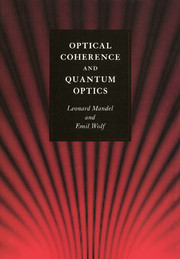Book contents
- Frontmatter
- Contents
- Preface
- 1 Elements of probability theory
- 2 Random (or stochastic) processes
- 3 Some useful mathematical techniques
- 4 Second-order coherence theory of scalar wavefields
- 5 Radiation from sources of any state of coherence
- 6 Second-order coherence theory of vector electromagnetic fields
- 7 Some applications of second-order coherence theory
- 8 Higher-order correlations in optical fields
- 9 Semiclassical theory of photoelectric detection of light
- 10 Quantization of the free electromagnetic field
- 11 Coherent states of the electromagnetic field
- 12 Quantum correlations and photon statistics
- 13 Radiation from thermal equilibrium sources
- 14 Quantum theory of photoelectric detection of light
- 15 Interaction between light and a two-level atom
- 16 Collective atomic interactions
- 17 Some general techniques for treating interacting systems
- 18 The single-mode laser
- 19 The two-mode ring laser
- 20 The linear light amplifier
- 21 Squeezed states of light
- 22 Some quantum effects in nonlinear optics
- References
- Author index
- Subject index
8 - Higher-order correlations in optical fields
Published online by Cambridge University Press: 05 April 2013
- Frontmatter
- Contents
- Preface
- 1 Elements of probability theory
- 2 Random (or stochastic) processes
- 3 Some useful mathematical techniques
- 4 Second-order coherence theory of scalar wavefields
- 5 Radiation from sources of any state of coherence
- 6 Second-order coherence theory of vector electromagnetic fields
- 7 Some applications of second-order coherence theory
- 8 Higher-order correlations in optical fields
- 9 Semiclassical theory of photoelectric detection of light
- 10 Quantization of the free electromagnetic field
- 11 Coherent states of the electromagnetic field
- 12 Quantum correlations and photon statistics
- 13 Radiation from thermal equilibrium sources
- 14 Quantum theory of photoelectric detection of light
- 15 Interaction between light and a two-level atom
- 16 Collective atomic interactions
- 17 Some general techniques for treating interacting systems
- 18 The single-mode laser
- 19 The two-mode ring laser
- 20 The linear light amplifier
- 21 Squeezed states of light
- 22 Some quantum effects in nonlinear optics
- References
- Author index
- Subject index
Summary
Introduction
In the preceding chapters we have been largely concerned with the simplest coherence effects of optical fields, namely those which depend on the correlation of the field variable at two space-time points (r1, t1) and (r2, t2). As we have seen, these effects include the most elementary coherence phenomena involving interference, diffraction and radiation from fluctuating sources.
In this chapter we present an extension of the theory to cover more complicated situations, which have to be described by correlations of higher order, i.e. by correlations of the field variables at more than two space-time points or the expectation values involving various powers and products of the field variables. Situations of this kind have become of considerable importance since the development of the laser and of nonlinear optics. The basic difference between the statistical properties of thermal light and laser light can, in fact, only be understood by going beyond the elementary second-order correlation theory.
Many of the higher-order coherence phenomena are most clearly manifest in the photoelectric detection process, which can only be adequately described by the quantum theory of detection or by taking into account the quantum features of the field, both of which will be studied in the succeeding chapters. However, because the field is still described classically in the semi-classical theory of light detection, and also because the classical field description provides a natural stepping stone to the quantum description of field correlations, we will now discuss the general description of field correlations of all orders on the basis of the classical theory of the fluctuating wavefield.
- Type
- Chapter
- Information
- Optical Coherence and Quantum Optics , pp. 422 - 437Publisher: Cambridge University PressPrint publication year: 1995



